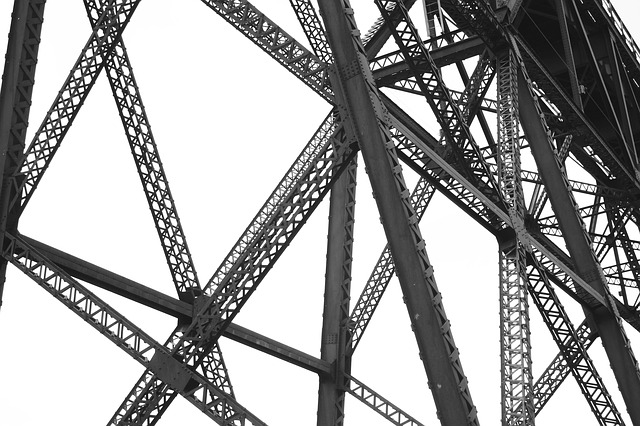Types of steel for construction

|
Contents |
[edit] Introduction
Steel is one of the most commonly used materials in civil engineering due to its high strength, durability and relatively low cost. It is an alloy of iron and a number of other elements including carbon. Manufacturers produce different types of steel by varying the type and quantity of alloy components, as well as the production process and the manner in which they are worked.
The different mechanical and physical properties that are required for the specific application determine the type of steel that is produced. Grading systems identify steels based on properties such as:
- Elasticity.
- Density.
- Melting point.
- Thermal conductivity.
- Strength.
- Hardness.
There are many different types of steel, broadly categorised according to their chemical composition into the following groups:
[edit] Carbon steel
Carbon steel is a combination of iron and carbon. The percentage of carbon is varied to produce different qualities of steel. The higher the level of carbon, the stronger, but more brittle the steel tends to be:
- Low carbon steel is easily workable. Wrought iron is a form of low carbon steel, often used for decorative ironwork such as railings and gates.
- Medium carbon steel can be used for structural steelwork.
- High carbon steel is often used for the manufacture of tools and high-strength wire.
- Ultra-high carbon steel is non-malleable, hard and brittle. Cast iron is a form of ultra-high carbon steel.
[edit] Alloy steel
Alloy steels are produced from carbon steel and one or more alloying elements. These additions can improve the mechanical properties of the alloy. For example, steel combined with manganese is very hard and strong, while steel combined with aluminium is more uniform in appearance.
Weathering steel (also known by the trademark COR-TEN steel) is a form of high-strength, low alloy steel, chemically composed to form a stable, rust-like appearance that can resist corrosion and abrasion, by forming a protective surface layer, or patina.
Steel combined with chromium (and sometimes nickel) is called stainless steel. Stainless steels do not generally form rust on their surfaces and do not discolour. The level of chromium is typically between 10-20%, with a level of 11% making the steel around 200 times more corrosion resistant than steels that contain no chromium. Stainless steel can be classified into three main categories based on their metallurgical structure: austenitic, ferritic and martensitic. For more information, see Stainless steel.
Tool steels are steels containing varying amounts of tungsten, molybdenum, cobalt and vanadium that have properties that are particularly suitable for forming tools and can be used to create moulds for injection moulding. They are abrasion, impact and/or corrosion resistant.
[edit] Galvanised steel
Galvanisation can be used to help prevent steel from corroding. This involves coating steel in zinc. The coating of zinc prevents corrosive substances from reaching the base metal. The zinc also acts as a sacrificial anode, meaning that if the coating is scratched, the remaining zinc will still protect the exposed steel.
[edit] Related articles on Designing Buildings
Featured articles and news
ECA progress on Welsh Recharging Electrical Skills Charter
Working hard to make progress on the ‘asks’ of the Recharging Electrical Skills Charter at the Senedd in Wales.
A brief history from 1890s to 2020s.
CIOB and CORBON combine forces
To elevate professional standards in Nigeria’s construction industry.
Amendment to the GB Energy Bill welcomed by ECA
Move prevents nationally-owned energy company from investing in solar panels produced by modern slavery.
Gregor Harvie argues that AI is state-sanctioned theft of IP.
Heat pumps, vehicle chargers and heating appliances must be sold with smart functionality.
Experimental AI housing target help for councils
Experimental AI could help councils meet housing targets by digitising records.
New-style degrees set for reformed ARB accreditation
Following the ARB Tomorrow's Architects competency outcomes for Architects.
BSRIA Occupant Wellbeing survey BOW
Occupant satisfaction and wellbeing tool inc. physical environment, indoor facilities, functionality and accessibility.
Preserving, waterproofing and decorating buildings.
Many resources for visitors aswell as new features for members.
Using technology to empower communities
The Community data platform; capturing the DNA of a place and fostering participation, for better design.
Heat pump and wind turbine sound calculations for PDRs
MCS publish updated sound calculation standards for permitted development installations.
Homes England creates largest housing-led site in the North
Successful, 34 hectare land acquisition with the residential allocation now completed.
Scottish apprenticeship training proposals
General support although better accountability and transparency is sought.
The history of building regulations
A story of belated action in response to crisis.
Moisture, fire safety and emerging trends in living walls
How wet is your wall?
Current policy explained and newly published consultation by the UK and Welsh Governments.
British architecture 1919–39. Book review.
Conservation of listed prefabs in Moseley.
Energy industry calls for urgent reform.



























